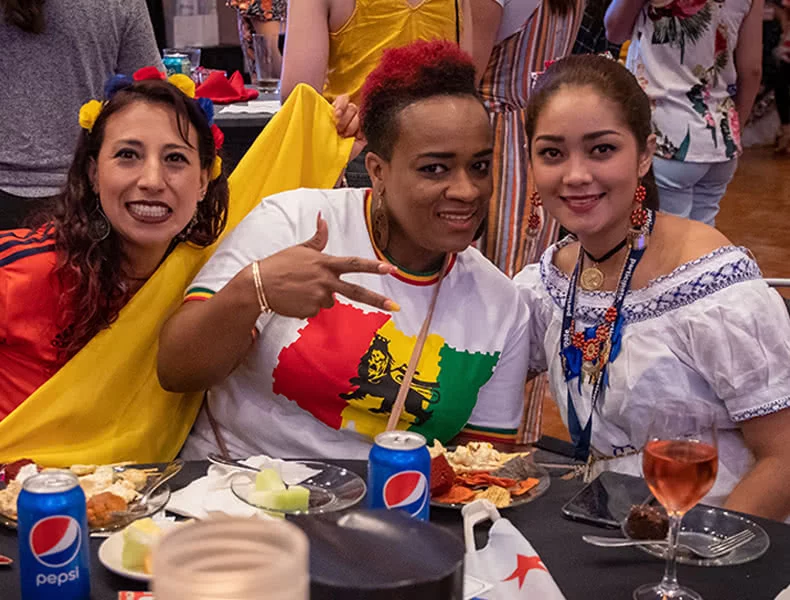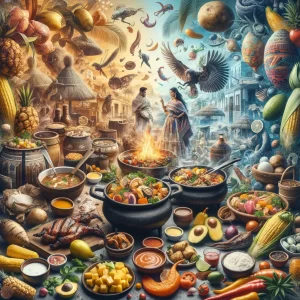Traditional cooking techniques represent more than mere methods of food preparation; they constitute a vibrant tapestry intricately woven into the cultural fabric of communities worldwide. These time-honored practices not only preserve unique flavors and ingredients but also reflect the history, heritage, and identity of specific regions.
An exploration of various traditional cooking techniques reveals their significance across diverse cultures and how they contribute to shaping regional identities. From the rich pasta traditions of Italy to the aromatic spices of India and the bold flavors characteristic of Mexican cuisine, one can uncover the profound connections that exist between food, culture, and community.
What Are Traditional Cooking Techniques and Their Cultural Significance?
.jpg_00.jpeg)
Traditional cooking techniques represent a comprehensive array of culinary practices that have been transmitted through generations, embodying the culinary heritage and cultural significance of diverse cultures worldwide. These practices contribute to the preservation of regional identities and the celebration of food traditions that are integral to community identity.
These techniques frequently employ local ingredients and highlight distinctive flavor profiles that reflect the identities of specific regions. By preserving these methods, communities cultivate a deeper appreciation for their food traditions, engaging in culinary storytelling that enhances their cultural narratives and enriches the collective history of cuisine.
1. Definition of Traditional Cooking Techniques
Traditional cooking techniques encompass the methods and practices developed over centuries that shape how food is prepared and enjoyed across various cultures, underscoring the significance of local ingredients, regional flavors, and food preservation techniques.
These techniques often reflect the historical influences and evolution of cuisine within different geographic regions. For instance, methods such as fermenting, smoking, and roasting have been transmitted through generations, illustrating how communities have maximized available resources to enhance flavor and preserve food.
The diversity of techniques is notable; in one culture, the intricacies of hand-rolled pasta signify a profound connection to the land, while in another, slow-cooked stews exemplify the harmonious interplay of spices and seasonal produce.
By upholding these practices, both chefs and home cooks contribute to the vitality of culinary diversity, safeguarding the unique stories and traditions that characterize their heritage, while embracing culinary innovation and sustainability.
2. Importance of Traditional Cooking Techniques in Culture and Identity
The significance of traditional cooking techniques extends beyond the realm of food preparation; they serve as essential cultural expressions that shape community identity, reinforce social bonds, preserve traditions across generations, and highlight the role of food as identity and cultural pride.
These methods often encapsulate a rich history, transmitted through familial lines, which reveals much about the heritage of a community, including family recipes and food rituals that are central to identity formation.
For many, the act of cooking transcends mere functionality and becomes a form of storytelling, where recipes convey narratives of ancestors, celebrations, and the landscapes from which the ingredients are sourced.
As culinary storytellers, individuals not only pass down these techniques but also foster a sense of pride and belonging among community members. By actively engaging with these time-honored practices, individuals continuously connect with their roots, ensuring that their unique food identity flourishes in the face of an evolving culinary landscape.
How Do Traditional Cooking Techniques Differ Across Regions?
Traditional cooking techniques exhibit considerable variation across different regions, influenced by local ingredients, distinct flavor profiles, and the unique gastronomic practices that characterize each culture’s cuisine, highlighting the culinary roots and regional biodiversity present in these practices.
These variations not only reflect the diversity of culinary practices but also underscore the impact of geographical and climatic factors on cooking methods, ingredient sourcing, and the culinary narratives that emerge within communities.
1. Regional Ingredients and Flavors
Regional ingredients are fundamental in defining the flavors of traditional dishes, with each locality presenting a distinctive array of tastes that reflects its culinary diversity, heritage, and the sensory experiences associated with traditional dishes.
These local components not only enhance the overall flavor but also convey a narrative of the land and its inhabitants. For example, in the Mediterranean, olive oil serves as a foundational element, imparting a rich, fruity essence that elevates dishes such as pasta and salads.
In the Pacific Northwest, the utilization of fresh salmon exemplifies the region’s abundant marine resources, resulting in dishes that are vibrant with natural flavors. Similarly, the spicy, smoky character of chipotle peppers is representative of Mexican cuisine, contributing depth and complexity to salsas and sauces.
Such distinctive ingredients not only shape flavor profiles but also cultivate a connection between communities and their culinary traditions.
2. Cooking Methods and Tools
.jpg_01.jpeg)
The cooking methods and tools employed in traditional cuisine can differ significantly, reflecting the cultural heritage and available resources of each region, ranging from indigenous cooking practices to contemporary adaptations.
These practices not only highlight the distinct flavors and techniques refined over generations but also embody the narratives and traditions that have been passed down through families.
For example, the utilization of clay pots in Mediterranean cuisine not only enhances flavor but also connects to preparation methods that have been utilized for centuries. Similarly, the vibrant application of spices in Indian cuisine illustrates a rich tapestry of historical influences and trade routes.
Incorporating modern technology, many chefs now blend traditional techniques with contemporary culinary innovations, resulting in exciting new dishes that honor their origins while pushing the boundaries of creativity.
This demonstrates how the journey of food represents a continual evolution intertwined with cultural identity and adaptability.
3. Influences from Surrounding Cultures
Traditional cooking techniques are frequently shaped by the surrounding cultures, resulting in a complex tapestry of cross-cultural culinary practices that evolve and adapt over time, leading to the emergence of unique regional specialties.
This evolution is particularly evident in the manner in which local ingredients and cooking methods work together with those introduced by immigrant communities, creating distinct dishes that narrate their origins.
For example, the fusion of Spanish and indigenous flavors in Caribbean cuisine illustrates how traditional practices can transform over time, giving rise to flavorful creations such as mofongo and paella.
Similarly, the combination of Asian spices with American cooking styles has resulted in the popularity of dishes like California rolls, which underscore the innovative nature of culinary traditions.
These examples highlight how cross-cultural interactions not only preserve heritage but also inspire new culinary endeavors that reflect the rich diversity of human experience, promoting multiculturalism and cultural exchange within food culture.
Examples of Traditional Cooking Techniques from Different Regions
Traditional cooking techniques are exemplified in the diverse regional cuisines found worldwide, each highlighting unique ethnic dishes, historical recipes, and time-honored practices that represent the culinary heritage and cultural diversity of their respective cultures.
1. Italian Cuisine
Italian cuisine is widely recognized for its emphasis on local ingredients, traditional recipes, and cooking methods that prioritize fresh produce and authentic flavors. This results in a culinary landscape that is both rich in history and steeped in tradition, showcasing taste heritage and the identity expression of Italian gastronomy.
The commitment to quality is evident in the diverse techniques employed across Italy’s various regions, ranging from the rustic simplicity of hand-rolled pasta in Tuscany to the intricate layering of flavors found in a Neapolitan ragù. Each technique not only reflects the culinary practices of the region but also highlights the cultural significance of the dishes, demonstrating the pride local chefs take in preserving their heritage through gastronomy.
Ingredients such as sun-ripened tomatoes, fragrant basil, and aged cheeses are often prominently featured, emphasizing not only the flavors but also the seasonal cycles of the land.
This meticulous approach to cuisine ensures that every bite conveys a narrative, effectively connecting the diner to the essence of Italian culture and its vibrant traditions, highlighting cultural practices and the role of food as a tool for culinary storytelling.
2. Indian Cuisine
Indian cuisine is distinguished by its extensive variety of traditional cooking techniques that employ a diverse range of spices and regional ingredients, resulting in complex flavor profiles that exemplify the country’s rich culinary diversity.
From the slow-cooked curries of the North to the vibrant, coconut-infused dishes of the South, each region presents unique methods that have been preserved and passed down through generations. Grilling, steaming, and pickling constitute essential components of this intricate culinary tapestry, illustrating the significant influence of various cultures on local practices.
The careful utilization of spices such as cumin, coriander, and turmeric not only enhances flavor but also offers health benefits, rendering Indian cuisine both palatable and nutritious, and emphasizing the importance of cooking as art and culinary symbolism.
The art of tempering, or ‘tadka,’ serves as an excellent example of how a seemingly simple process can elevate a dish, underscoring the profound connection between tradition and innovation within this culinary landscape, while fostering culinary workshops and food education.
3. Mexican Cuisine and Its Culinary Roots
.jpg_10.jpeg)
Mexican cuisine exhibits a rich variety of traditional foodways and cooking techniques, deeply rooted in indigenous practices that emphasize communal meals, food storytelling, and the sensory experiences of culinary traditions, thereby highlighting the cultural significance and communal spirit of food rituals.
These time-honored methods, including nixtamalization and slow-cooking techniques, not only enhance the rich flavors inherent in ingredients such as corn and chilies but also establish a connection to ancestral heritage and regional identities. Each dish often conveys a narrative that has been passed down through generations, reflecting the history of the region and its inhabitants.
For example, the preparation of tamales during festive occasions serves as a ritual that reinforces family bonds, cultural identity, and showcases regional flavors and traditional knowledge.
The utilization of communal cooking methods, such as the traditional comal, underscores the importance of shared experiences and cultural practices, bringing friends and family together in celebration and resonating with the communal spirit that is fundamental to Mexican culinary culture.
How Do Traditional Cooking Techniques Shape Regional Identities?
Traditional cooking techniques play a crucial role in shaping regional identities, as they reflect the cultural heritage, local ingredients, and food customs of a community.
These practices foster a sense of belonging, identity formation, and strengthen community bonds through shared culinary experiences and food rituals.
1. Connection to History and Heritage
The relationship between traditional cooking techniques and food history is significant, as these practices serve as vehicles for cultural transmission, preserving culinary heritage across generations and ensuring the continuity of traditional foodways and cultural storytelling.
These time-honored methods not only reflect the local climate and available resources but also encapsulate the narratives and identities of communities. For example, the art of fermentation, prevalent in various cultures—from kimchi in Korea to sauerkraut in Germany—demonstrates how families have adapted their recipes over centuries, thereby contributing to nutritional preservation, traditional meal preparation, and enhancing flavor complexity.
Techniques such as stone-ground milling and slow-cooking are passed down with great pride, often through oral storytelling or shared family gatherings. These practices reinforce familial bonds, food as identity, and impart knowledge about cultural roots to younger generations.
Ultimately, such traditions underscore the invaluable role of traditional foodways in sustaining cultural identity and fostering a sense of belonging.
2. Cultural Significance and Celebration
Traditional cooking techniques possess significant cultural importance, often serving as central elements during celebrations and traditional festivals. These events unite communities through food rituals, cultural exchanges, and communal meals.
These culinary practices not only preserve time-honored recipes and methods but also reinforce a sense of identity, cultural pride, and belonging among participants. During cultural festivities, the preparation and sharing of meals provide opportunities for storytelling, laughter, and the transmission of customs from one generation to the next.
Communal cooking and dining cultivate relationships among families, neighbors, and friends, effectively transforming simple acts of nourishment into meaningful expressions of unity, heritage cuisine, and tradition.
As individuals gather around a table filled with traditional dishes, they not only enjoy diverse flavors but also celebrate their shared heritage and strengthen their social connections.
3. Impact on Local Economy
The impact of traditional cooking techniques on the local economy is considerable, as it drives culinary tourism, gastronomy tourism, and promotes sustainable cooking practices that honor local food customs and heritage ingredients.
These practices not only attract food enthusiasts in search of authentic experiences but also encourage community engagement and support for local farmers. When visitors travel to a region for its distinctive culinary offerings, they frequently contribute to the economy through expenditures on dining, accommodations, local markets, and related activities.
For example, regions known for their traditional dishes, such as Tuscany in Italy, often experience a significant boost in local businesses, ranging from local markets that sell fresh produce to culinary workshops that teach artisanal skills.
The focus on sustainable cooking techniques and preservation techniques fosters a cycle that preserves local biodiversity, thereby enhancing both the food ecosystem and the entrepreneurial spirit of the community.
Frequently Asked Questions
.jpg_11.jpeg)
What are traditional cooking techniques?
Traditional cooking techniques refer to methods of food preparation that have been passed down through generations within a specific culture or region. These techniques often involve the use of local ingredients and specialized tools to create dishes that are unique to the area.
How do traditional cooking techniques define regional identities?
Traditional cooking techniques are a reflection of a region’s cultural and historical influences. The ingredients, tools, and methods used in cooking are often closely tied to the local landscape, climate, and cultural traditions. As a result, traditional dishes and cooking techniques become an integral part of a region’s identity.
What are some examples of traditional cooking techniques that define regional identities?
Examples of traditional cooking techniques that define regional identities include grilling techniques used in Southern cuisine, the use of clay pots in Mexican cuisine, and the slow-cooking methods used in French cuisine. These techniques have been passed down through generations and are an important part of the food culture in their respective regions.
Why is it important to preserve traditional cooking techniques?
Preserving traditional cooking techniques allows for the continuation of a region’s unique culinary identity. It also helps to maintain cultural heritage and promotes sustainability by utilizing local ingredients and reducing the reliance on processed or imported foods.
How have modern advancements in cooking technology impacted traditional cooking techniques?
Modern advancements have made cooking faster and more convenient, but they have also led to a decline in the use of traditional cooking techniques. This has caused a loss of regional identities and cultural heritage in some areas. However, there has also been a resurgence in interest in traditional techniques, leading to a fusion of modern and traditional cooking methods in many cuisines.
Can traditional cooking techniques be adapted for modern cooking?
Yes, traditional cooking techniques can be adapted for modern cooking. Chefs and home cooks often incorporate traditional techniques into their dishes, while also utilizing modern equipment and ingredients. This allows for the preservation of cultural identity while also keeping up with evolving food trends.

My name is Bruno, I have been a writer for 5 years and I work with website creation. My goal is to provide true information to readers. In fact, on this site I write about cultures and traditions, which I have been passionate about since childhood.




